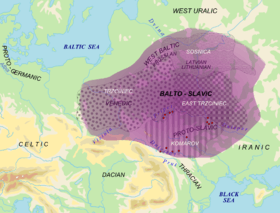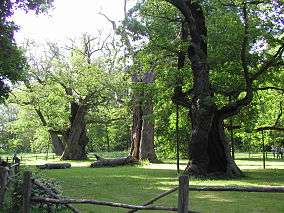Lech, Czech, and Rus
Lech, Czech, and Rus (Czech pronunciation: [lɛx tʃɛx rus]) refers to a founding myth of three Slavic peoples: the Poles (or Lechites), the Czechs, and the Rus' people. The three legendary brothers appear together in the Wielkopolska Chronicle, compiled in the early 14th century. The legend states that the brothers, on a hunting trip, followed different prey and thus travelled (and settled) in different directions; Lech in the north, Czech in the west, and Rus in the East. There are multiple versions of the legend, including several regional variants in Poland and the Czech Republic that mention only one or two of the brothers.
Polish version

In the Polish version of the legend, three brothers went hunting together but each of them followed a different prey and eventually they all traveled in different directions. Rus went to the east, Čech headed to the west to settle on the Říp Mountain rising up from the Bohemian hilly countryside, while Lech traveled north. There, while hunting, he followed his arrow and suddenly found himself face-to-face with a fierce, white eagle guarding its nest from intruders. Seeing the eagle against the red of the setting sun, Lech took this as a good omen and decided to settle there. He named his settlement Gniezno (Polish gniazdo - 'nest') in commemoration and adopted the White Eagle as his coat-of-arms. The white eagle remains a symbol of Poland to this day, and the colors of the eagle and the setting sun are depicted in Poland's coat of arms.
According to Wielkopolska Chronicle (13th century), Slavs are descendants of Javan, the son of Japheth, the son of Noah. He had three sons - Lech (the oldest), Rus, and Čech (the youngest), who decided to settle west, north, and east.[1][2][3][4][5][6]
Czech version
A variant of this legend, involving only two brothers, is also known in the Czech Republic. The apparently best known version by the 19th century author Alois Jirásek appeared in his retelling of Staré pověsti české (Ancient Bohemian Legends). While the older chronicles from 14th century (such as those of Dalimil, Wenceslaus Hajek and Přibík Pulkava z Radenína) the location of Čech and Lech's homeland Charvaty is not specified, in the work of Jirásek it is more closely determined; Za Tatrami, v rovinách při řece Visle rozkládala se od nepaměti charvátská země, část prvotní veliké vlasti slovanské (Behind the Tatra Mountains, in the plains of the river Vistula, stretched from immemorial time Charvátská country (probably White Croatia), the initial part of the great Slavic homeland), and V té charvátské zemi bytovala četná plemena, příbuzná jazykem, mravy, způsobem života (In Charvátská existed numerous tribes, related by language, manners, and way of life).[7] However, numerous battles had made the country very unfavorable for the people, which were accustomed to live in peace, cultivate the land and grow grain.

According to other versions, the reason was that Čech had been accused of a murder. They gathered their people and set off towards the sunset. As in the Polish version, Čech is identified as the founder of the Czech nation (Češi pl.) and Lech as the founder of the Polish nation.
According to the Chronicle of Dalimil (1314), when Čech and his people climbed Říp Mountain, he looked upon the landscape and told his brothers that they have reached the promised land: a country where there are enough of beasts, birds, fish and bees so that their tables will be always full, and where they could defend themselves against enemies.[8] He settled in the area with a tribe and, according to the Přibík Pulkava version (circa 1374), his brother Lech continued his journey to the lowlands over the snowy mountains of the north, where he founded Poland.[9]
Wenceslaus Hajek's version from 1541 adds many (probably fanciful) details not found in other sources. According to Hájek, the brothers were dukes who had already owned castles in their homeland before their arrival in the region and dates their arrival to the year 644.[8]
Other variants
A similar legend (with partly changed names) was also registered in folk tales at two widely separated locations in Croatia: in the Kajkavian dialect of Krapina in Zagorje (northern Croatia) and in the Chakavian dialect of Poljica on the Adriatic Sea (central Dalmatia). The Croatian variant was described and analysed in detail by S. Sakač in 1940.[10]
Legend versus reality
In the Bohemian chronicles, Čech appears on his own or only with Lech. Čech is first mentioned in Latin as Bohemus in the Cosmas' chronicle of 1125. The earliest Polish mention of Lech, Čech, and Rus is found in the Chronicle of Greater Poland[11] written at the end of the 13th or the beginning of the 14th century.

The legend suggests the common ancestry of the Poles, Czechs and Rus people, and illustrates the fact that as early as the 13th century at least three different Slavic peoples were aware of being ethnically and linguistically interrelated and, indeed, derived from a common root stock. The legends also agree on the location of the homeland of the Slavic peoples in eastern Europe. This area overlapped the region presumed by mainstream scholarship to be the Proto-Indo-European homeland in the general region of the Pontic-Caspian steppe.[12] In the framework of the Kurgan hypothesis, "the Indo-Europeans who remained after the migrations became speakers of Balto-Slavic".[13]
The legend also attempts to explain the etymology of the ethnonyms: Lechia (another name for Poland), the Czech lands (including Bohemia, Moravia, and Silesia), and Rus' A prominent Renaissance Polish man of letters, Jan Kochanowski, in his essay on the origin of the Slavs, makes no mention of the third "brother", Rus. Moreover, he dismisses the legend entirely, stating that "no historian who has taken up the subject of the Slavic nation [...] mentions any of those two Slavic leaders, Lech and Czech". He goes on to assume that "Czechy" and "Lechy" are quite probably the original names for the two nations, although he does not dismiss the possibility that there might have been a great leader by the name Lech whose name replaced the original and later forgotten name for the Polish nation.[14]
Legacy
Oaks of Rogalin
Three large oaks in the garden adjacent to the 18th-century palace in Rogalin, Greater Poland, are named after the brothers (Lech, Czech i Rus), and are several hundred years old.[15] They vary between 670 and 930 centimetres (22 and 31 ft) in circumference. They are part of the Rogalin Landscape Park, and together with other they have been declared nature monuments and placed under protection.[16]
See also
| Wikimedia Commons has media related to Lech (Polish forefather). |
| Wikimedia Commons has media related to Čech. |
- Lech – a Bohemian prince who was killed in the war with Charlemagne's army in 805
- Kyi, Shchek and Khoryv
- Qais Abdur Rashid, whose three legendary sons are said to have founded the modern Pashtun nation
- Fénius Farsaid, a legendary Scythian prince who is said to have founded the modern Irish nation and invented the Ogham Irish alphabet
References
- ↑ Czesław Łuczak, Kazimierz Tymieniecki, Europa, Słowiańszczyzna, Polska. 1970. p. 296.
- ↑ Brygida Kurbisówna, Studia nad Kroniką wielkopolską, Poznańskie Towarzystwo Przyjaciół Nauk, Poznań 1952.
- ↑ Adam Fałowski, Bogdan Sendero, Biesiada słowiańska, Universitas, Kraków 1992, p. 40.
- ↑ Kultura polski średniowiecznej XIV-XV w. pod red. B. Geremka, Wydawnictwo Naukowe Semper, Warszawa 1997, p. 651.
- ↑ Kronika wielkopolska, wstęp i tłum. K. Abgarowicz, Warszawa 1965; UNIVERSITAS, Poznań 2010, ISBN 978-83-242-1275-0.
- ↑ Kronika Dalimila [in:] LitDok Europa Środkowo-Wschodnia, Herder-Institut, Marburg.
- ↑ Alois Jirásek. "4". Staré pověsti české. ISBN 9788088061144. Retrieved 29 August 2015.
- 1 2 "Praotec Čech". hora-rip.cz. Retrieved 29 August 2015.
- ↑ Přibík Pulkava
- ↑ Krapina-Kijev-Ararat, Priča o troje braće i jednoj sestri. Život 21/3: 129–149, Zagreb
- ↑ "Fix hiis itaque Pannoniis tres fratres filii Pan principis Pannoniorum nati fuere quorum primogenitus Lech, alter Rus, tercius Czech nomine habuerunt. Et hii tres hec tria regna Lechitarum, Ruthenorum, et Czechorum quit et Bohemi [...] Germo est quaddam instrumentum in quo duo boves simul iuncti trahendo aratrum seu plaustrum incedunt, sic et Theutunici cum slavis regna contigua habentes simul ..." Translation: Among the Pannonians, therefore, three brothers were born to Pan, prince of the Pannonians. The first was named Lech, the second Rus and the third Czech. These three held the three kingdoms of the Lechites [Poles], Ruthenians and Czechs (or Bohemians) […] Germo is a type of vehicle in which two oxen are yoked together to draw a plough or pull a cart, and so the Germans and the Slavs, having common borders, pull together; there is no people in the world so familiar and friendly to one another as the Slavs and Germans. [in:] Chronica Poloniae Maioris. Kronika Wielkopolska. ed. and commentary by Brygida Kürbis. Warszawa 1970
- ↑ Anthony, David W. (2007). The Horse, the Wheel, and Language: How Bronze Age Riders from the Eurasian Steppes Shaped the Modern World. Princeton, NJ: Princeton University Press. ISBN 978-0-691-05887-0.
- ↑ F. Kortlandt, The spread of the Indo-Europeans, p.4
- ↑ Jan Kochanowski, Proza polska, Universitas, Kraków 2004, pp. 19-21 (in Polish)
- ↑ Taylor, Patrick (2006). The Oxford Companion to the Garden. Oxford University Press. p. 411. ISBN 0-198-66255-6.
- ↑ "Dęby rogalińskie", Catalog of protected objects (retrieved October 7, 2016)
